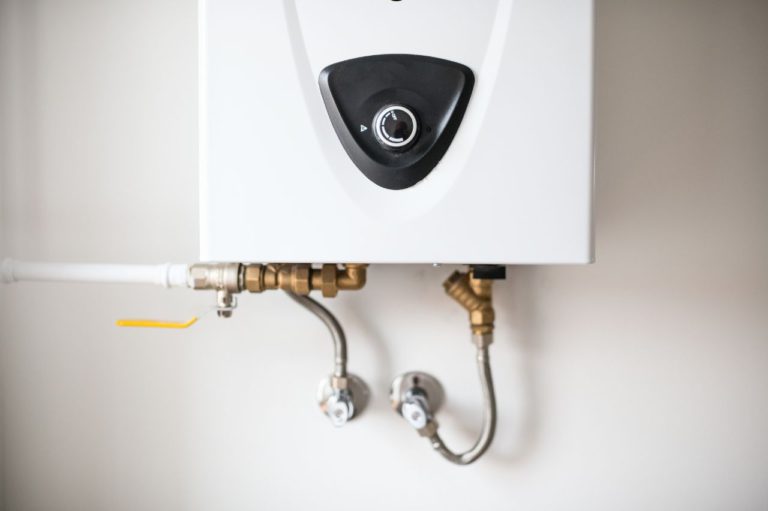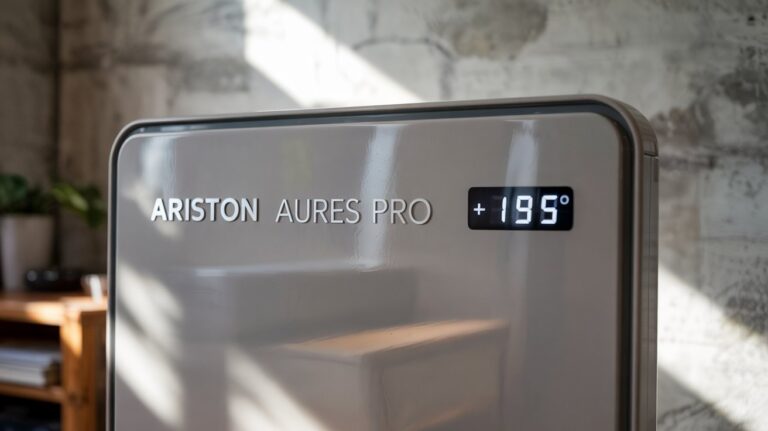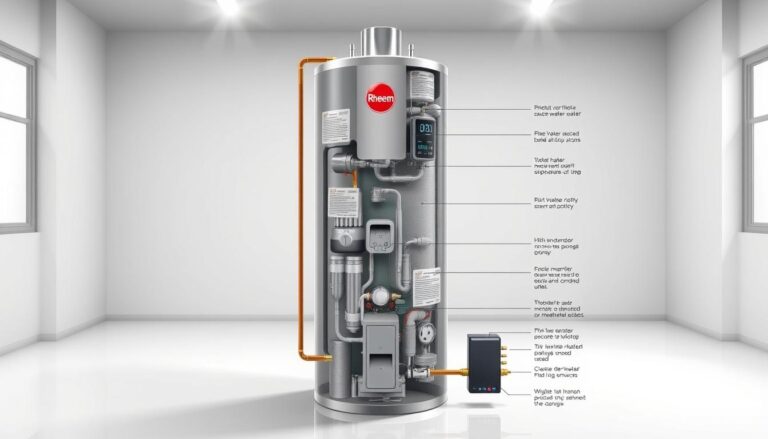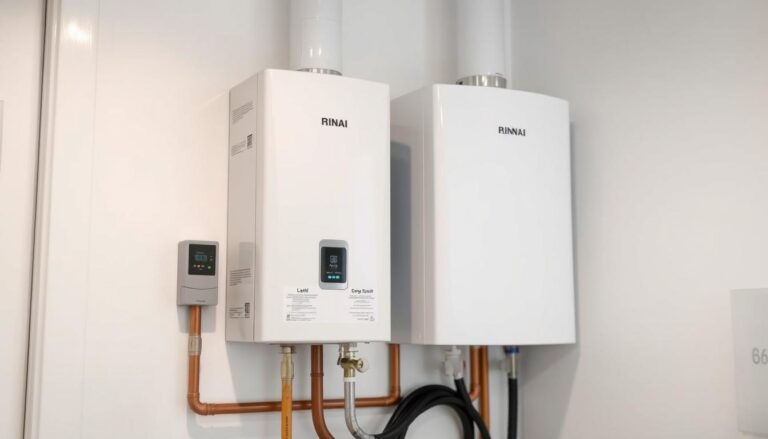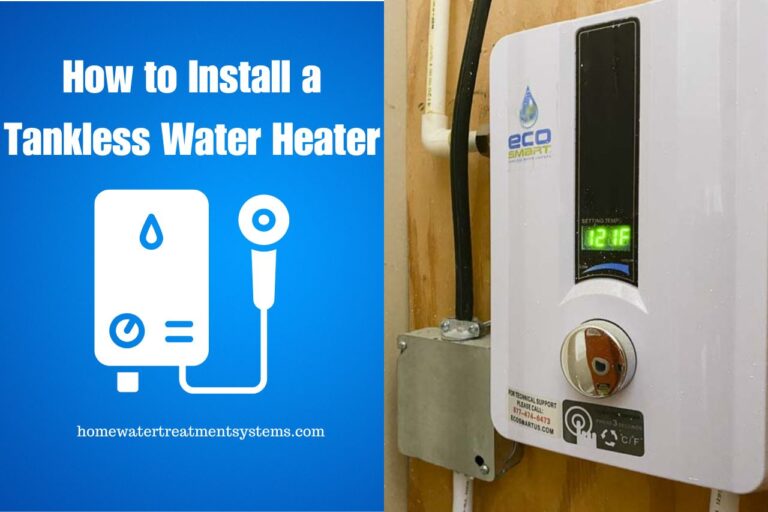What Does an Anode Rod Do?
Are you aware of the unsung hero that protects your water heater from corrosion? It’s called an anode rod, a crucial component that plays a significant role in maintaining the longevity of your water heater.
The anode rod is made from a more active metal than the steel of the tank, attracting and reacting to the corrosiveness of water. By doing so, it safeguards the tank from damage, ensuring your water heater functions efficiently.
This sacrificial rod is essential for preventing corrosion and extending the lifespan of your water heater. Understanding its significance can help you maintain your water heater effectively.
Key Takeaways
- The anode rod protects the water heater tank from corrosion.
- It is made from a more active metal than the tank’s steel.
- The rod attracts and reacts to water’s corrosiveness.
- Sacrificing itself to safeguard the tank.
- Regular maintenance can extend the water heater’s lifespan.
Understanding the Purpose of Anode Rods
The anode rod’s primary function is to safeguard your water heater tank against corrosion. This is achieved through a process known as sacrificial protection, where the anode rod corrodes in place of the tank.
The Unsung Hero of Your Water Heater
The anode rod is often referred to as the “unsung hero” because it sacrifices itself to protect the water heater tank from corrosion. By doing so, it extends the lifespan of the water heater. The rod is typically made of a more reactive metal than the tank, such as magnesium or aluminum, which corrodes more easily.
Basic Function and Importance
The basic function of an anode rod is to attract corrosive elements in the water, thereby protecting the tank. This is crucial because once the tank is corroded, it can leak and cause significant damage. The importance of the anode rod cannot be overstated, as it is a simple and effective way to extend the life of your water heater.
| Anode Rod Material | Corrosion Resistance | Typical Lifespan |
|---|---|---|
| Magnesium | High | 3-5 years |
| Aluminum | Medium | 5-7 years |
| Zinc-Aluminum Alloy | High | 7-10 years |
As
“The anode rod is a critical component that protects the water heater from corrosion, thereby extending its lifespan.”
Regular inspection and maintenance of the anode rod are essential to ensure it continues to function effectively.
What Does an Anode Rod Do? The Science Explained
The anode rod is a crucial component that protects your water heater from corrosion through a fascinating scientific process. To understand its role, we need to delve into the science behind its operation.
The Sacrificial Protection Process
The anode rod works through a process known as sacrificial protection. Essentially, it sacrifices itself to protect the water heater tank from corrosion. This is achieved by the anode rod being made of a material (such as magnesium or aluminum) that is more reactive than the steel of the water heater tank. As a result, when in contact with water, the anode rod attracts corrosive elements, thereby protecting the tank.
Sacrificial protection is a widely used method for preventing corrosion in water heaters. By corroding in place of the tank, the anode rod extends the lifespan of the water heater. Regular inspection and replacement of the anode rod are crucial to maintaining this protection.
Electrochemical Reaction in Water Heaters
The process by which anode rods prevent corrosion involves an electrochemical reaction. When the anode rod is submerged in water, it initiates a reaction where the metals in the rod attract ions that would normally cause rust in the iron and steel of the water heater tank. This reaction is fundamental to the functioning of the anode rod.
| Component | Role in Electrochemical Reaction |
|---|---|
| Anode Rod | Sacrifices itself to protect the tank by attracting corrosive ions |
| Water Heater Tank | Protected from corrosion by the anode rod’s sacrificial action |
| Water | Facilitates the electrochemical reaction between the anode rod and the tank |
By understanding the electrochemical reaction and the sacrificial protection process, it’s clear why anode rods are vital for the longevity of water heaters. Regular maintenance of the anode rod is essential to ensure continued protection.
Types of Anode Rods for Different Water Conditions
Anode rods come in various materials, each designed to protect your water heater in different water conditions. The choice of anode rod material can significantly impact the longevity and performance of your water heater.
Magnesium Anode Rods
Magnesium anode rods are one of the most common types used in water heaters. They are highly effective in protecting the tank from corrosion, especially in areas with soft water. Magnesium rods are sacrificial, meaning they corrode in place of the tank, thus extending its lifespan. However, they may not be the best choice for areas with hard water, as they can be consumed too quickly.
Aluminum Anode Rods
Aluminum anode rods are another popular option, particularly suited for hard water conditions. They offer a longer lifespan compared to magnesium rods in such environments. Aluminum rods are less reactive than magnesium, making them a good choice for households with hard water. However, they may not provide the same level of protection in soft water conditions.
Zinc-Aluminum Alloy Anode Rods
Zinc-aluminum alloy anode rods combine the benefits of both materials, offering a balanced performance in various water conditions. They provide a good compromise between the reactivity of zinc and the durability of aluminum. These rods are particularly effective in reducing the sulfur smell often associated with water heaters.
Powered Anode Rods
Powered anode rods are an advanced type that uses a small electrical current to protect the water heater tank. They are highly effective and can last significantly longer than traditional sacrificial anodes. Powered anode rods are particularly useful in areas with very corrosive water conditions.
Choosing the right anode rod depends on the specific water conditions in your area. Understanding the characteristics of each type can help you make an informed decision to protect your water heater effectively.
Benefits of a Properly Functioning Anode Rod
A properly functioning anode rod is crucial for the longevity and efficiency of your water heater. By protecting the tank from corrosion, anode rods play a vital role in maintaining the overall health of your water heating system.
The benefits of a well-maintained anode rod are multifaceted, impacting various aspects of your water heater’s performance.
Extended Water Heater Lifespan
One of the primary benefits of a functioning anode rod is the extension of your water heater’s lifespan. By sacrificing itself to protect the tank, the anode rod helps prevent corrosion that can lead to premature failure. This means you can enjoy hot showers and reliable hot water for a longer period without the need for costly replacements.
Improved Water Quality
A properly functioning anode rod also contributes to improved water quality. By reducing the risk of corrosion, it helps maintain the integrity of the water heater tank, ensuring that your hot water remains clean and free from contaminants. This is particularly important for households with young children or individuals with compromised immune systems.
Energy Efficiency Considerations
Furthermore, a well-maintained anode rod can positively impact your water heater’s energy efficiency. When the tank is protected from corrosion, it can operate more efficiently, reducing the energy required to heat your water. This not only saves you money on your utility bills but also contributes to a more sustainable household.
Signs Your Anode Rod Needs Replacement
Anode rods play a vital role in protecting your water heater from corrosion, but they don’t last forever. Over time, the anode rod sacrifices itself to protect the water heater tank, and when it’s significantly deteriorated, it needs to be replaced.
Visual Indicators of Deterioration
One of the most straightforward ways to determine if your anode rod needs replacement is by inspecting it visually. Signs of deterioration include heavy corrosion, significant reduction in diameter, or if the rod is broken or fragmented. If you notice any of these signs, it’s likely time for a replacement.
Water Quality Changes
A deteriorating anode rod can lead to changes in your water quality. Indicators include rusty or discolored water, unusual odors, or an increase in sediment in your hot water. These changes can signal that the anode rod is no longer effectively protecting your water heater.
Timeline for Typical Replacement
The lifespan of an anode rod varies depending on the water conditions and the type of rod used. Generally, anode rods can last anywhere from 3 to 5 years. Regular inspections can help determine when a replacement is needed. It’s recommended to check the anode rod every 2 years to ensure it’s still in good condition.
How to Inspect Your Water Heater’s Anode Rod
Inspecting your water heater’s anode rod is a crucial maintenance task that can significantly extend the lifespan of your water heater. Regular inspections help identify potential issues before they become major problems, ensuring your water heater operates efficiently and safely.
Tools You’ll Need
To inspect your anode rod, you’ll need a few basic tools. These include a socket wrench or breaker bar to loosen the anode rod, a pair of gloves to protect your hands from sharp edges, and a flashlight to illuminate the inside of your water heater. Having the right tools is essential for a safe and effective inspection.

Step-by-Step Inspection Process
The inspection process involves several key steps. First, turn off the power to your water heater and shut off the water supply. Next, locate the anode rod on top of your water heater and use your socket wrench to loosen it. Carefully lift the rod out and inspect its condition. If it’s heavily corroded or worn down, it needs to be replaced. This simple process can help you identify potential issues early on.
Safety Precautions
Safety is paramount when inspecting your anode rod. Always turn off the power and water supply before starting. Be cautious when handling the anode rod as it may be hot or have sharp edges. Wearing protective gloves and eyewear can prevent injuries. Additionally, ensure the area is well-ventilated to avoid inhaling any fumes. Following these safety precautions is crucial for a safe anode rod inspection.
The Anode Rod Replacement Process
Maintaining your water heater involves periodically replacing the anode rod, a task that’s easier than you think. Replacing an anode rod can be done DIY, but some situations may require professional assistance. Understanding when and how to replace the anode rod is crucial for the longevity of your water heater.
DIY Replacement Steps
Replacing an anode rod involves several straightforward steps. First, turn off the power supply to your water heater. For electric heaters, this means switching off the breaker, while for gas heaters, you’ll need to set the thermostat to “pilot.”
Next, locate the anode rod on top of the water heater. Use a socket wrench to loosen and remove the rod. Inspect the rod for signs of wear and take note of its condition.
To install a new anode rod, simply reverse the process. Ensure the new rod is properly seated and tightened securely.
| Step | Description | Tools Needed |
|---|---|---|
| 1 | Turn off power supply | Breaker or thermostat |
| 2 | Locate and remove anode rod | Socket wrench |
| 3 | Inspect and replace rod | New anode rod |
When to Call a Professional
If you encounter a stubborn or corroded anode rod, it may be time to call a professional. Additionally, if you’re unsure about any part of the replacement process, seeking professional help can prevent potential damage to your water heater.
Professionals have the necessary tools and experience to handle complex replacements, ensuring the job is done correctly and safely.
Dealing with Stubborn or Corroded Rods
Sometimes, anode rods can become stuck due to corrosion. In such cases, applying penetrating oil can help loosen the rod. If the rod still doesn’t budge, it’s best to seek professional assistance to avoid damaging the water heater.
Key Takeaways:
- Turn off power supply before starting
- Use proper tools for removal and installation
- Know when to call a professional
Common Anode Rod Problems and Solutions
Common issues with anode rods can significantly impact the efficiency and lifespan of your water heater. Understanding these problems and their solutions is crucial for maintaining your water heater’s health and ensuring it operates effectively.
Excessive Corrosion Issues
Excessive corrosion is a common problem with anode rods, often resulting from the rod’s sacrificial protection process. When the anode rod corrodes, it protects the water heater tank from rust. However, if the corrosion is too rapid, it may not provide adequate protection, leading to potential leaks.
Solution: Regularly inspect the anode rod and replace it when it’s significantly corroded. Using a more durable anode rod material, such as an aluminum or zinc-aluminum alloy, can also help mitigate excessive corrosion.
Sulfur Smell in Hot Water
A sulfur smell in hot water can be alarming and is sometimes related to the anode rod. Magnesium anode rods, in particular, can react with certain water conditions to produce hydrogen sulfide gas, which smells like sulfur.
Solution: Consider replacing a magnesium anode rod with an aluminum or zinc anode rod, as these are less likely to cause sulfur smells. Additionally, checking the water quality and treating it if necessary can help alleviate this issue.
Sediment Buildup Concerns
Sediment buildup in the water heater tank can be another issue related to anode rods, especially if the rod is not functioning correctly or if the water is particularly hard.
Solution: Regularly flushing the water heater tank can help reduce sediment buildup. Ensuring the anode rod is in good condition and considering a water softener for hard water can also mitigate this problem.
Unusual Noises Related to Anode Rods
Sometimes, unusual noises from the water heater can be linked to anode rod issues, such as sediment buildup or corrosion.
Action: Inspect the anode rod and the tank for sediment. Flushing the tank and replacing the anode rod if necessary can often resolve these noises.

Anode Rod Maintenance Tips for Longevity
Anode rod maintenance is a simple yet effective way to prolong the lifespan of your water heater. By implementing a few straightforward practices, you can ensure your anode rod functions optimally, thereby protecting your water heater from corrosion.
Regular Inspection Schedule
Regular inspections are crucial for identifying potential issues before they become major problems. It’s recommended to check your anode rod every 6 to 12 months, depending on your water heater’s usage and local water conditions. During inspection, look for signs of corrosion or wear, such as significant reduction in rod diameter or fragmentation.
Water Treatment Considerations
The quality of your water supply plays a significant role in the longevity of your anode rod. Hard water, water with high sulfur content, or water with other contaminants can accelerate corrosion. Consider installing a water treatment system to mitigate these effects and prolong the life of your anode rod.
Complementary Maintenance Practices
In addition to regular anode rod inspections, other maintenance practices can contribute to the overall health of your water heater. These include flushing the tank annually to remove sediment, checking the temperature and pressure relief valve, and ensuring proper insulation around the water heater.
| Maintenance Task | Frequency | Benefits |
|---|---|---|
| Anode Rod Inspection | Every 6-12 months | Early detection of corrosion |
| Tank Flushing | Annually | Removes sediment, improves efficiency |
| Temperature & Pressure Relief Valve Check | Every 6 months | Ensures safety, prevents overpressure |
By following these anode rod maintenance tips, you can significantly extend the life of your water heater and ensure it continues to operate efficiently.
Cost Considerations: Anode Rods vs. Water Heater Replacement
When considering the longevity of your water heater, it’s essential to weigh the costs of anode rod maintenance against full replacement. The anode rod is a critical component that protects your water heater from corrosion, and its maintenance can significantly impact the overall cost of owning a water heater.
Price Range for Anode Rod Types
The cost of anode rods varies significantly based on the type and material. Magnesium anode rods, for instance, are generally more affordable, ranging from $20 to $50. Aluminum anode rods can cost between $30 to $60, while zinc-aluminum alloy rods may range from $40 to $80.
Professional Installation Costs
While DIY installation is possible, many homeowners opt for professional installation to ensure the job is done correctly. The cost for professional installation can range from $100 to $300, depending on the complexity of the job and local labor rates.
Long-term Savings Analysis
Replacing an anode rod is generally more cost-effective than replacing the entire water heater. By extending the life of your water heater through anode rod replacement, you can delay the significant expense of purchasing and installing a new water heater, potentially saving thousands of dollars.
“Investing in anode rod maintenance can lead to substantial long-term savings.” As
“Regular maintenance is key to extending the life of your water heater.”
, emphasizing the importance of anode rod replacement in overall water heater maintenance.
Conclusion
Anode rods are a critical component in water heater maintenance, playing a vital role in preventing corrosion and ensuring the efficient operation of water heaters. By understanding the significance of anode rods, homeowners can take proactive steps to extend the lifespan of their water heaters and maintain optimal performance.
Regular inspection and maintenance of anode rods are essential to prevent excessive corrosion and ensure the water heater operates efficiently. By replacing anode rods as needed and following proper maintenance tips, homeowners can enjoy long-term savings and improved water quality.
Effective water heater maintenance involves more than just checking the anode rod; it also includes considering water treatment options and complementary maintenance practices. By adopting a comprehensive maintenance approach, homeowners can maximize the efficiency and lifespan of their water heaters, ultimately saving money and reducing the need for premature replacements.


